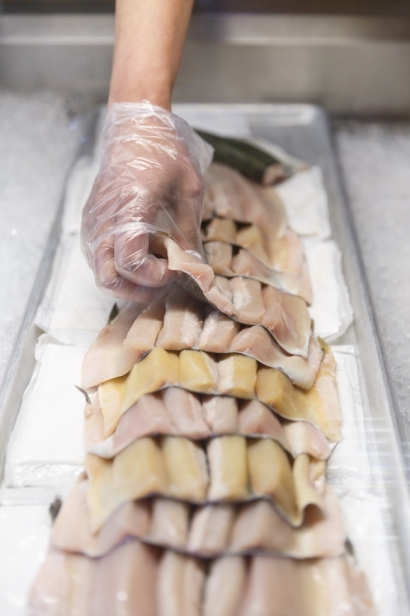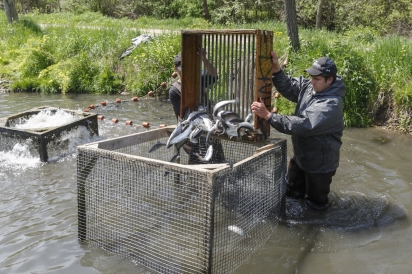Sustainable Seafood
Sustainability in the fish industry is vitally important to maintaining the quality and quantity of the fish population for future generations. Three local food professionals have uncovered innovative sustainability processes: Sitka Salmon Shares created a transportation and sales model for Alaskan fish; Rushing Waters, an established organic Wisconsin trout farm, embraces transparency across the board; and Screaming Tuna, a popular player in the local sushi game, maintains strict sustainability standards as a way of doing business.
The message “Eat Local, Think Global,” planted the seed for Sitka Salmon Shares. Nic Mink, the company’s founder/Chief Salmon Steward is a Wisconsin native and UW-Madison graduate. He explains, “Sitka was born as a local food movement in Madison. I went to the farmers’ market; I was a member of the CSA. I ended up moving to Alaska after more than a decade in the Madison food world.”
During a 2009-2010 stint at the Sitka Conservation Society, Mink discovered he could combine two of his passions: high quality food and preserving the environment. “We hoped to create an eco-label for fish from these amazing, pristine watersheds and habitats in southeast Alaska,” Mink said. He committed to bridging the gap between consumer consumption and sustainable fishing. “I was interested in branding that has a component of an environmental message and helps raise awareness of environmental issues around food,” Mink adds.
Mink and two students from the Environmental Studies classes he teaches at Knox College in Illinois came home from a trip to Alaska with boxes of Sitka salmon. Mink’s friends loved the fish so much, it spawned a business (pun intended). Mink explains, “The idea was to create awareness about sustainability issues and motivate people to choose fish from this region. Our pipe dream was to fundraise for college internships.” Mink’s concept has grown into a thriving cooperative for fish and seafood and has a group of obsessed followers.
Commitment to quality and sustainability begins on the water. “The fishermen are harvesting for the future; they fish for low volume quality rather than high volume commodity…here you have conservation and quality totally aligned.” Mink adds.
Sitka has a unique process for preserving and freezing fish. As Mink explains, “Fish is never going to get better than the moment it’s pulled out of the water. One of the most important things you can do is get that fish’s core temperature down to 32-degrees.” Mink regularly battles an unjustified stigma around frozen fish. “If you bleed a fish, gut a fish, gill a fish, and ice a fish, you’re taking all of those things that decompose the quickest out of the fish. If you don’t do those things, you’ve got twelve hours. If you do everything you can to ensure that fish doesn’t decompose, you can have a superior product four days later,” Mink adds.
For photographer Craig Stodola and his wife Angie, it was love at first bite. “My wife and I tried Sitka salmon and halibut at La Merenda, and we went home and joined Sitka,” Stodola says. The CSA model was the perfect way for the Stodolas to combine a love of good food with growing concerns about health. “We were taking fish oil pills because it’s good for your heart, but why take pills when we can just eat fish?” Stodola wondered. The Stodolas were disappointed in store-bought salmon. “We purchased farm-raised salmon from stores and it was always a little bit mushy,” Stodola recalls. Sitka changed all that. “We love being able to trace Sitka fish back to its source…we love the Copper River salmon, the halibut, the black cod. My kids love it too. The rock fish is fish taco heaven,” Stodola says.
Decades before the birth of the field-to-fork movement, Rushing Waters had already perfected the pond-to-plate concept in Palmyra, Wisconsin. Rushing Waters has been raising rainbow trout since the 1940s, and today they have fifty six ponds on their eighty acres in the heart of the Kettle Moraine State Forest. The secrets to Rushing Water’s success are Mother Nature and an ongoing commitment to quality. Co-owner Peter Fritsch explains, “We’ve all heard ‘location, location, location’…we have this abundant pristine water source an hour out of Milwaukee, which means we’re close enough to the markets to have this fresh fish available to restaurants and retailers within twenty four hours.”
Consistent water temperature is another reason Rushing Waters raises the highest quality trout. “We do this year ‘round. The water is 50-degrees and it never freezes, but one of the biggest challenges is what Mother Nature throws our way. When we get big snowfalls, our farmers have to plow their way in there.” Fritsch explains. Fritsch and his team take pride in being excellent stewards of their environment. “We don’t take shortcuts; we don’t use antibiotics or chemicals. We’re doing aquaculture the way it should be done,” he adds.
Rushing Waters serves the rainbow trout at their company-owned restaurants, both aptly named The Trout House. With locations in Delavan and on-site at Rushing Waters, these restaurants have become the go-to for trout-loving diners. The Trout House at Rushing Waters allows diners the unique opportunity to tour the facility, visit the ponds and catch their own fish through the restaurant’s unique “Hook and Cook” program.
Day-in and day-out, Fritsch and his Rushing Waters team live their motto “When quality matters.” He explains, “We raise our fish in natural ponds with low population densities and we use non-GMO soybean meal; it’s the most expensive feed on the market.” Fritsch realizes the impact of these decisions. “Everyone loves clean water and people have to remember we have the most to lose by not having clean water. We spend a lot of time and money managing this resource because it’s our duty to protect it,” he adds.
Kermit the Frog could have been foreshadowing the sustainability movement in the fish industry when he sang “It’s Not Easy Being Green.” But for Jeff Bronstad and his team at Screaming Tuna, sustainability has become their modus operandi. As Bronstad explains, the concept initially came from a customer. “About five years ago, a customer who knew a lot about sustainable sushi asked us about it and we decided to look into it,” Bronstad explains. “We found vendors that had marine biologists on staff.”
Screaming Tuna signed with the Monterey Bay Aquarium Seafood Watch, which sets the standards for sustainability in America with sushi. “We sign a contract not to serve anything on the Seafood Watch Avoid List, including unagi and hamachi (which you find in every restaurant because they’re sushi staples). We had to switch from unagi, which is freshwater eel, to saltwater eel; and we switched from hamachi to kampachi.”
The primary difference is the way the fish population is managed and how the fish is processed. “Russia and the U.S. catch crab in the same location in the Bering Sea. Russia takes their crab and processes it in Russia and Alaskan crab is processed in Alaska. Russian crab doesn’t have documentation of where it went after they caught it.” Bronstad adds. “But we have clear documentation of the crab’s journey from the ocean to the restaurant.” Over the years, this commitment has become easier. “I have a pretty good idea of what is sustainable and I’ll read up on it and make sure it’s copacetic. Our executive chef Jason Morimoto also has a pretty good idea of what’s going to work and a good grasp of sustainability,” Bronstad says.
Customer response has been very positive. “It feels good to get the positive feedback, but it’s just something we choose to do. We were the first restaurant in Wisconsin to partner with Monterey Bay and the first sushi place in the Midwest…we would absolutely do the same thing in whatever endeavor we decide to do next.” Bronstad adds. “If enough people start only buying sustainable seafood, the market for the unsustainable seafood market drops away and hopefully those endangered or semi-endangered populations can recover. We do pay a little more for our fish than normal fish…we’re investing in the future so there can be sushi restaurants.”







